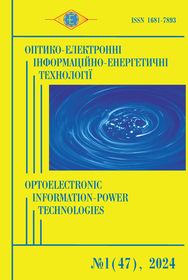Classification model of digital coding methods
DOI:
https://doi.org/10.31649/1681-7893-2024-47-1-42-49Keywords:
classification, coding, immunity, corrective property.Abstract
In modern computer applications, efficient processing of digital information requires optimal coding of digital data, especially considering the speed and immunity of processing and transmission of coded information. This work is devoted to the classification analysis of known coding methods with an emphasis on their immunity. Jam-resistant codes play a key role in ensuring the reliability and efficiency of information transmission, as well as ensuring its integrity in critical object processing, analysis and recognition systems. An extended version of the classification model of coding methods is proposed, which uses the basic characteristics of codes according to the algebraic theory of coding. This classification is supplemented among single codes by a single even code, among multi-valued codes by the Fibonacci code, among cyclical codes by a modified Eliez code. In addition, a list of modern cyclic codes is given. From the point of view of immunity, two cyclic codes are considered: a modified Elaies code and a single positional code. A comparison of the corrective properties of the Elaies code, the modified Elaies code and the Hamming code was performed. As a result, it is shown that the modified Elaies code allows correcting triple errors in the rows of the correction matrix and detecting triple errors in the columns of the correction matrix. A comparative analysis of two unit codes, positional and normal with the Hamming code, was made. Therefore, the single positional code, like the Hamming code, is capable not only of detecting, but also of correcting single errors. This functional power of the unit positional code is contained in the way of encoding its combinations in contrast to the Hamming code, in which control symbols are provided.
References
Zhurakovskyi Y.P. and Poltorak V.P., Theory of information and coding. Kyiv, Ukraine: Higher School, 2001.
Azarov O.D., Garnaga V.A., Klyatchenko Y.M., and Tarasenko V.P., Computer circuit engineering. Textbook. Vinnytsia, Ukraine: VNTU, 2018.
Adams S.S., Introduction to Algebraic Theory. 2008, p. 67 [Electronic resource]. – Access mode: http://mirmillion.free.fr/Efrei.pdf.
Neubauer A., Freudenberger J. and Kuhn V, Coding Theory: Algorithms, Architectures and Applications. Chichester, England: Willy-interscience, 2007.
Babich M.P. and Zhukov A.I., Computer circuit engineering. Training manual. Kyiv, Ukraine: MK-Press, 2004.
Berlekamp E., Algebraic Coding Theory. New York: McGraw-Hill, 1968.
Semerenko V.P., Theory of cyclic codes based on automatic models. Monograph. Vinnytsia, Ukraine: VNTU, 2015.
Luzhetsky V.A., Highly reliable mathematical Fibonacci processors. Monograph. Vinnytsia, Ukraine: "UNIVERSUM - Vinnytsia", 2000.
Azarov O.D., Fundamentals of the theory of analog-digital conversion based on redundant positional counting systems. Monograph. Vinnytsia, Ukraine: UNIVERSUM, 2004.
O.D. Azarov, Bit-by-bit analog-to-digital conversion based on counting systems with weight redundancy. Monograph. Vinnytsia, Ukraine: UNIVERSUM, 2010.
Ya. Grozmani, P. Maidan, D. Makaryshkin, K. Sokolan, and G. Radelchuk, "Modeling of the automatic control system of an autonomous mobile robot", Measuring and computing technology in technological processes, issue 4, p. 240-244 . 2023.
Tsmots I.G., Teslyuk V.M., Opotyak Y.V., Partsei R.V. and. R.V. Zinko "Basic architecture of a mobile robotics platform with an intelligent motion control system and data transmission protection", Ukrainian Journal of Information Technologies, vol. 3, no. 2, p. 74–80. 2021.
Metzner J. J. “On Correcting Bursts (and Random Errors) in Vector Symbol (n, k) Cyclic Codes”, Trans. Inform. Theory, Vol. 54, No. 4. 2008.
Semerenko V. P., "Estimation of the correcting capability of cyclic codes based on their automation models", Eastern European Journal of Enterprise Technologies, c.16-24. 2015.
Costello D.J., Hagenauer J., Imai H., and Wicker S.B., “Applications of error-control coding”. Transactions on Information Theory, c.2531 – 2560. 1998.
Kozhemyako V.P., Martynyuk T.B., Dmytruk V.V., and Vlasiichuk V.V., "Classification of unit codes", Optical-electronic information and energy technologies, No. 1 (11), p. . 36-42. 2006.
V.I. Slyusar, "Synthesis of LDPC and polar codes based on matrices", Development of science, education and business, p.64-79. 2020.
N.T. Berezyuk, Coding of information. Kharkiv, Ukraine: Higher School, 1978.
Semerenko V.P. "Theory and practice of CRC codes: new results based on automatic models" Eastern European Journal of Advanced Technologies, c.38-47. 2015.
Voinalovich O., "Modification of iterative methods of decoding interference-resistant codes", at the XII International. science and practice conf. Internet-Education-Science, Vinnytsia, 2020, p. 107-108.
Martyniuk T., Kozhemyako A., Bortnyk G. and Voinalovich O. "Analysis of the characteristics of analog-digital conversion "duration-code", Bulletin of the Khmelnytskyi National University, vol. 1, No. 1, p. 135-138. 2023.
Downloads
-
PDF (Українська)
Downloads: 85
Published
How to Cite
Issue
Section
License
Автори, які публікуються у цьому журналі, погоджуються з наступними умовами:- Автори залишають за собою право на авторство своєї роботи та передають журналу право першої публікації цієї роботи на умовах ліцензії Creative Commons Attribution License, котра дозволяє іншим особам вільно розповсюджувати опубліковану роботу з обов'язковим посиланням на авторів оригінальної роботи та першу публікацію роботи у цьому журналі.
- Автори мають право укладати самостійні додаткові угоди щодо неексклюзивного розповсюдження роботи у тому вигляді, в якому вона була опублікована цим журналом (наприклад, розміщувати роботу в електронному сховищі установи або публікувати у складі монографії), за умови збереження посилання на першу публікацію роботи у цьому журналі.
- Політика журналу дозволяє і заохочує розміщення авторами в мережі Інтернет (наприклад, у сховищах установ або на особистих веб-сайтах) рукопису роботи, як до подання цього рукопису до редакції, так і під час його редакційного опрацювання, оскільки це сприяє виникненню продуктивної наукової дискусії та позитивно позначається на оперативності та динаміці цитування опублікованої роботи (див. The Effect of Open Access).


